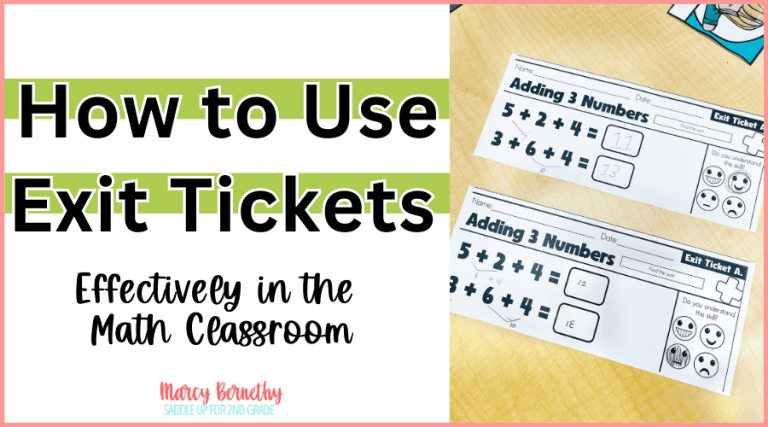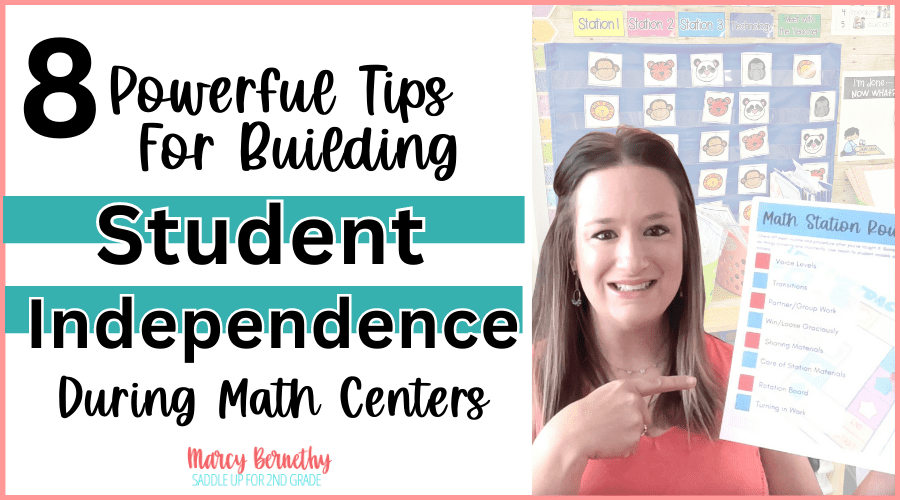

Join me for a FREE, Guided Math workshop to discover how to easily incorporate Guided Math into your current schedule!
Have you ever felt like your students are not independent enough to complete math centers effectively, without constantly interrupting you for help at the teacher table? If your math rotations feel a bit chaotic, this blog post is for you! I’m dishing out 8 powerful tips for building student independence during math centers so everyone can succeed during guided math groups.

Math centers (or stations as I like to call them) are a key element of the guided math framework. During math stations, students rotate through various activities independently while you are working with a group of students at the small group table to teach the new concept of focus.
I love station time because it’s a great way to engage students and reinforce skills they have previously learned. To read more about how to use math centers for spiral review, check out this blog post!
Many teachers that I’ve worked with inside of my Managing Math Stations course find it challenging to make the most of their math center time because their students struggle to work independently. This leads to student interruptions and frustrations during guided math groups. However, with these 8 powerful tips I’m going to share, you can help your students build independence during math centers.
Want to hear me explain these tips? Check out the YouTube video below!
The first tip for building student independence is to set and model expectations… a lot! Before your students can work independently, they need to understand what is expected of them.
You can’t just expect them to know what to do during math stations… you have to SHOW them. Take the time to explicitly demonstrate what their behavior during math centers should look like.
Here are a few routines that you should teach before starting math stations:
I’ve created a FREE math station routine checklist to help you keep track of the routines and procedures that need to be taught. You can grab your copy by filling out the form below and it’ll be sent straight to your inbox!
By modeling these expectations over and over again, you can help set your students up for success. This is also something I explicitly teach inside of Managing Math Stations. Enrollment opens up just a few times a year, so you can get on the waitlist to be the first to know when doors are open!
The next tip is to gradually release the responsibility from you as the teacher to the students. Inside of Managing Math Stations, I explain in great detail how it typically takes 5-6 weeks to get guided math and math centers fully up and running.
During that time, you are focusing on the gradual release method and implementing one math station at a time into your day. I don’t recommend that you get started by throwing 3-4 math centers out there and expecting your students to complete them properly in the beginning.
Start by providing more support and guidance during the initial stages of building student independence. As students become more comfortable with guided math routines and procedures, gradually decrease the level of support, allowing them to take more ownership of their learning.
One of the bonuses you get with Managing Math Stations is a step-by-step 5 week lesson plan guide that follows this process and empowers students to build independence.
Just like with anything, consistency is KEY when it comes to building student independence during math centers. Keeping the same routine for math stations helps students know what to expect and builds familiarity.
My math station system is very simple. Station 1 is always a math fact activity. Stations 2 and 3 are always a spiral review of a previously taught skill, as well as the technology station. Then you have the teacher table, which is where you do a majority of your teaching on the new concept being taught.
The activities will change throughout the month, but the routine will always stay the same. This consistent routine creates a sense of security and enables students to focus on the task at hand, without feeling lost or overwhelmed. This also benefits all students by allowing you to focus on the students at your small group table.
My next tip for building student independence is all about spiral review. Math centers are an excellent opportunity to reinforce and review previously taught skills. Read that again… PREVIOUSLY taught skills.
The activities that your students work on independently during math centers should be something they have already learned and can work on confidently by themselves.
Don’t make the mistake of including the skill you’re currently working on in your whole group mini lessons or small group lessons in your math center activities. That’s a recipe for confusion, frustration, and lots of interruptions!
This tip for building student independence was the one that took me the longest to figure out, but when I did, everything changed for the better!
You’re always going to have those students who struggle to remember the instructions for math center activities, what to do, and how to actually complete them. I used to waste SO MUCH of my instructional time showing students HOW to complete each station activity. The problem was, they would still forget and I would get interrupted at the small group table numerous times throughout our guided math rotations.
Then it hit me… why not create student instructional videos showing them the activity, what they need, and how to play?! I created an entire line of 2nd grade math centers that include student instructional videos to help solve this problem. Students simply scan a QR code on the direction page and it pulls up a video of me showing them how to complete the activity along with what materials they need. This one was a huge win for my math block and I think it will be for yours too.
Another way to foster student independence during math centers is by including self-checking activities, such as answer keys, QR codes, matching games, or activities that allow students to check their work independently. This encourages students to take ownership of their learning and make corrections on their own, promoting a growth mindset.
I often talk about how I do not grade math station work, but I do have students submit their work to me so I can review it. This goes back to setting those clear expectations from the beginning.
Each student has a math station folder where they keep track of their recording sheets. If you have access to student technology such as iPads or ChromeBooks, have students take pictures of their work and submit them to you via SeeSaw or another learning platform.
I love holding students accountable in this way because it also gives them the opportunity to ask me questions and I can give them feedback and support in return.
My final tip for building student independence is to provide students with a time to reflect on their learning. Inside their math station folder, include a weekly reflection sheet. Each day, they can jot down something they’ve learned and show their level of understanding.
They can use this as a time to tell you how partner work is going for them or just an opportunity to tell you something on their mind. You don’t need to check their reflection sheets daily, but try to check them 2-3 times a week. This is so valuable in helping them take credit for their own learning, which is another topic we dive into in depth in Managing Math Stations.
I hope these 8 tips help you encourage your students to become independent thinkers and learners so you can have great success with math stations.
If you’re looking for more resources to help you get started on the right foot, check out these options below.
I’d love to hear which tip stood out to you the most. Comment below and let me know!

Math should be fun, not stressful. Ditch the timed math fact tests and replace them with math games that will help your students learn and retain information more effectively.
© Saddle Up for 2nd Grade • Website by KristenDoyle.co


